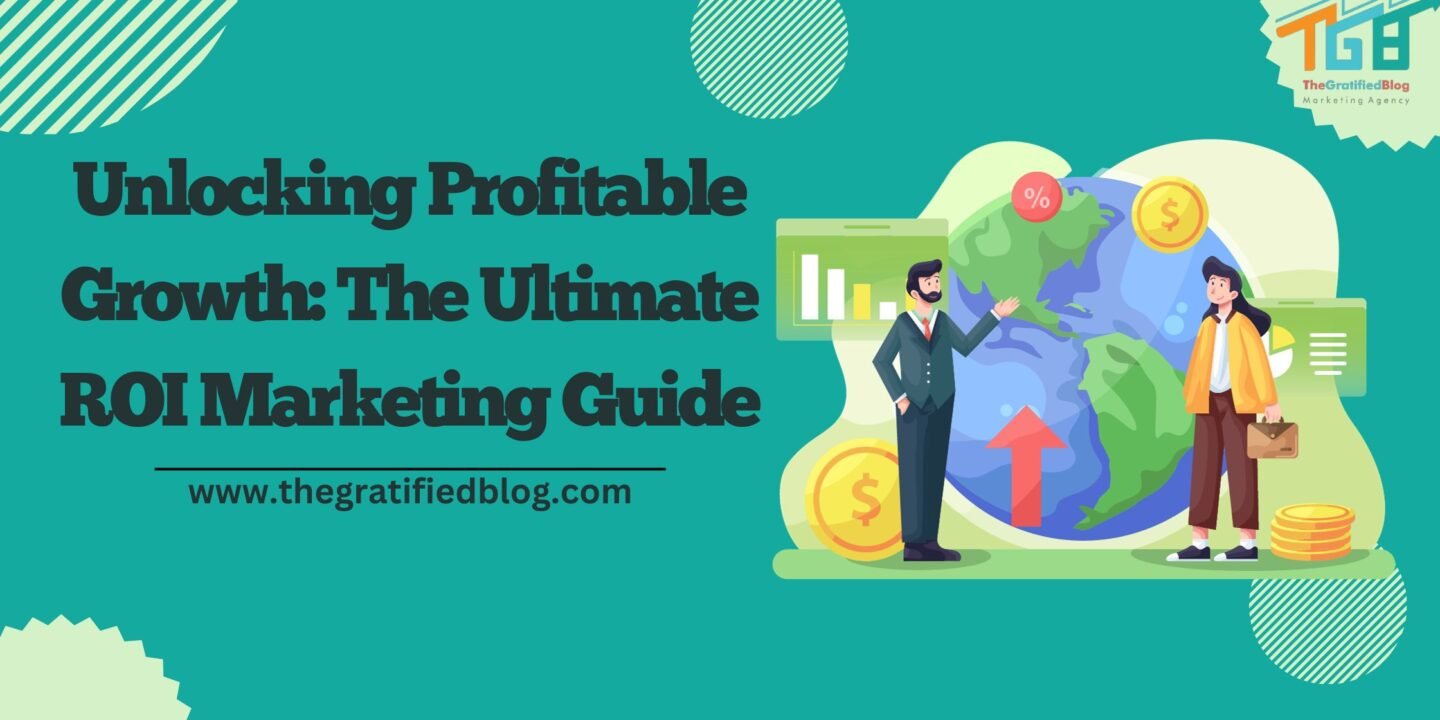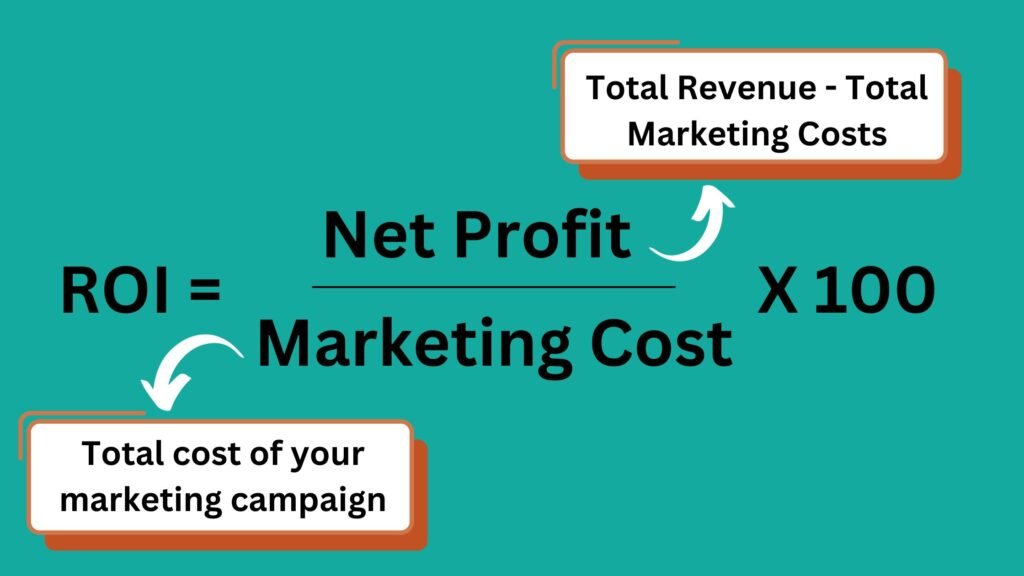
In the current dynamic digital environment, marketing has undergone evolution into a dynamic and data-driven field. As businesses allocate significant budgets to their marketing efforts, measuring and maximizing the return on investment (ROI) has become more critical.
This comprehensive guide delves into ROI marketing, exploring what it is, how to measure it, and its applications in social media and digital marketing.
What Is Marketing ROI?
ROI Marketing, or Return on Investment, is a key performance metric that assesses the profitability of your marketing campaigns. It gauges the effectiveness of your marketing endeavors by comparing the net profit generated from those efforts to the cost of the marketing activities.
Marketing ROI is pivotal in shaping marketing strategies for businesses of all sizes. It helps organizations answer crucial questions such as:
- Effectiveness Assessment: Is our marketing strategy delivering the expected results?
- Resource Allocation: Are we investing our resources wisely across different marketing channels?
- Budget Justification: Can we justify the marketing spend to stakeholders, shareholders, or management?
Why Understanding ROI Marketing Is Essential?
Understanding ROI in marketing is essential for several reasons:
- Resource Optimization: It enables businesses to allocate their marketing budget more efficiently by identifying high-performing channels and campaigns.
- Goal Alignment: ROI measurement ensures that marketing efforts align with overarching business goals, whether it’s increasing revenue, acquiring new customers, or enhancing brand awareness.
- Data-Driven Decision-Making: ROI helps marketers Make decisions informed by precise data rather than relying on intuition or guesswork.
How To Measure Marketing ROI?
Marketing ROI measurement involves a systematic approach that includes setting clear goals, tracking data, and performing calculations using a specific formula. Here’s a step-by-step guide:
Setting Clear Goals And Objectives
Before diving into ROI measurement, setting clear and realistic marketing goals is crucial. These objectives should be precise, measurable, and have a defined timeframe (S.M.A.R.T.). Marketing goals include increasing website traffic, boosting conversion rates, or raising brand awareness.
Marketing ROI Formula

The basic ROI formula is simple:
ROI = (Net Profit / Marketing Cost) x 100
- Net Profit: The revenue generated from your marketing efforts minus the total marketing cost.
- Marketing Cost: The total expenses incurred for your marketing activities, including ad spend, content creation, and marketing software.
The Significance Of Tracking And Data Analysis
Accurate data tracking is the cornerstone of ROI measurement. To measure ROI effectively, you need access to data sources that offer insights into your marketing initiatives. This includes tools like Google Analytics, social media analytics, and customer relationship management (CRM) systems.
How To Calculate Marketing ROI?

Calculating marketing ROI (Return on Investment) involves a straightforward formula that allows you to assess the profitability of your marketing efforts. Here are the steps to calculate marketing ROI:
ROI = (Net Profit / Marketing Cost) x 100
- Determine Net Profit: Calculate the net profit generated from your marketing campaign. Net profit is your total revenue minus the total marketing cost, including all expenses for running the campaign.Net Profit = Total Revenue – Total Marketing Costs.
- Total Revenue: This includes all the income generated directly from your marketing campaign. It could be the sales from products, services, or other conversions driven by your marketing efforts.
- Total Marketing Costs: This includes all expenses related to the marketing campaign, such as advertising spend, content creation costs, marketing software fees, and any other direct expenses.
- Calculate ROI: Use the formula to calculate ROI. Multiply the net profit by 100 to express it as a percentage.ROI = (Net Profit / Marketing Cost) x 100
- Net Profit is the result of step 1.
- Marketing Cost is the total cost of your marketing campaign.
- Interpret the Result: Your ROI will be expressed as a percentage. A positive ROI means that your marketing campaign generated more profit than it cost, indicating a profitable campaign. A negative ROI suggests that your campaign incurred more expenses than its generated revenue, indicating a loss.
Social Media Marketing ROI
Social media has revolutionized the way businesses interact with their audience. It has also become a prominent channel for marketing efforts. Measuring ROI in social media marketing is essential to measuring the effectiveness of your social media campaigns and justifying your investments.

Here are metrics for measuring social media ROI:
- Conversion Rates
Conversion rates quantify the proportion of users on social media who perform an intended action, such as finalizing a purchase or opting for a newsletter subscription. A high conversion rate signifies that your social media endeavors result in meaningful actions.
- Click-Through Rates (CTR)
It measures the number of clicks on your social media posts or ads relative to the number of impressions. An elevated CTR indicates that your content is captivating and compelling to your audience.
- Customer Acquisition Cost (CAC)
Through social media marketing efforts, CAC calculates the cost of acquiring a new customer. It helps in assessing the efficiency of your customer acquisition strategies.
Case Studies Showcasing Successful Social Media ROI
To illustrate the impact of social media ROI, let’s look at a couple of case studies:
Case Study 1: E-commerce Success
A clothing retailer launched a targeted Facebook ad campaign promoting their summer collection. They tracked their ROI over three months and found that for every $1 spent on ads, they generated $4 in revenue.
Case Study 2: B2B Lead Generation
A software company invested in LinkedIn-sponsored content to generate leads. By measuring their ROI, they determined that their LinkedIn campaigns brought in leads at a significantly lower cost compared to other marketing channels.
ROI For Digital Marketing
Digital marketing encompasses various online channels and strategies, including Search engine optimization (SEO), pay-per-click (PPC) advertising, email marketing, and content marketing are comprised in Measuring digital marketing ROI is essential to evaluate the effectiveness of each channel.
Here are key digital marketing channels and strategies:
- Return on Advertising Spend (ROAS)
ROAS quantifies the revenue derived from advertising campaigns compared to the cost of those campaigns. It’s a critical metric for PPC advertising and helps optimize ad spending for profitability.
- Customer Lifetime Value (CLV)
CLV evaluates the enduring worth of a customer. By calculating CLV, businesses can understand the potential revenue a customer can generate throughout their relationship with the company, guiding marketing efforts.
Real-World Examples Of Digital Marketing ROI
Example 1: SEO Investment
A small e-commerce business invested in an SEO strategy that included optimizing product listings and blog content. Over six months, they saw a 30% increase in organic website traffic, resulting in a 20% growth in online sales.
Example 2: Email Marketing
An online subscription service calculated its email marketing ROI. By monitoring the revenue from email campaigns, they discovered that for every $1 invested in email marketing, they generated $38.
Tools And Techniques For Measuring Marketing ROI
Accurate measurement of marketing ROI requires the right tools and techniques. Here are some essential resources:
- Marketing Analytics Platforms
Tools like Google Analytics, Adobe Analytics, and HubSpot provide in-depth insights into website traffic, user behavior, and conversion rates.
- CRM Systems and Customer Data
CRM systems like Salesforce and HubSpot CRM help manage customer data and track interactions, allowing for better ROI analysis.
- A/B Testing and Experimentation
A/B testing platforms, like Optimizely and VWO, enable marketers to conduct experiments and optimize their campaigns based on actual user data.
- Attribution Modeling
Attribution models, such as first-click, last-click, and multi-touch, Assist marketers in comprehending the customer journey and distributing credit to various touchpoints in the conversion path.
Challenges And Pitfalls In Measuring ROI
While measuring ROI is crucial, it has its challenges. Common obstacles marketers face include:
- Data Integration: Integrating data from various sources can be complex and time-consuming.
- Attribution Complexity: Determining which marketing touchpoints contribute most to conversions can be challenging.
- Short-Term vs. Long-Term Impact: Some marketing efforts may yield little results but contribute to long-term success.
Marketers can use data automation, advanced attribution modeling, and continuous monitoring to overcome these challenges.
Maximizing Marketing ROI
Now that we’ve explored how to measure ROI and overcome challenges let’s discuss strategies to maximize your marketing ROI.
- Experimentation and Testing
Regularly test different marketing strategies, channels, and messaging to identify what resonates best with your audience.
- Data-Driven Decision-Making
Base marketing decisions on data and insights rather than intuition. Continuously analyze your metrics to identify trends and opportunities.
- Budget Allocation
Distribute your marketing budget to channels that exhibit high performance and campaigns while being willing to adjust as ROI data evolves.
- Customer Segmentation
Segment your audience to deliver more targeted and personalized marketing campaigns, increasing the chances of higher ROI.
- Content Quality
Invest in high-quality content that engages your audience and provides value, ultimately driving better ROI.
Conclusion
Marketing ROI is the compass guiding businesses toward success. Measuring your ROI ensures that every marketing dollar is well spent, driving growth and profitability. Have questions or insights to share about ROI marketing? Feel free to comment below and join the conversation!
Thanks for reading:)








No Comments